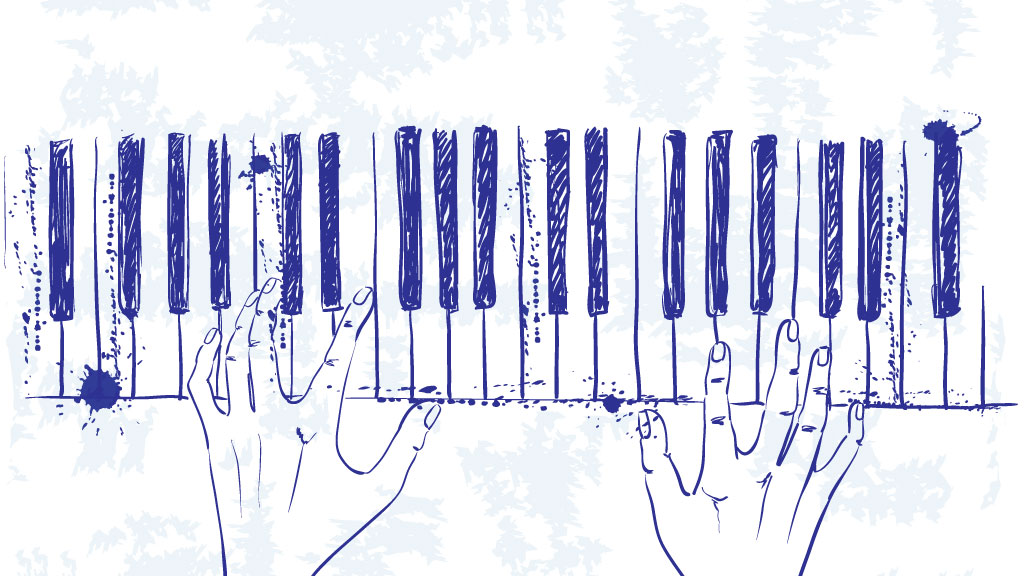Click here for your free pdf download of this lesson.
In this lesson, we explore a technique that is going to change your world as a stride piano player!
The technique is a walk-up chord progression that you can use to move between two chords, within the larger chord progression of the song.
In stride piano, a common move between chords is the distance of perfect fourth. For example, from C to F is a perfect fourth. From F to Bb is a perfect fourth. From G to C is perfect fourth, and so on.
To make this perfect-fourth move more interesting, we can “walk-up” from one chord to the next with a mini chord progression in between.
The Basic Walk-Up
First let’s walk up just the bass note by itself, using C major as an example. From C to F is a perfect fourth, so F is where we’re headed, and C is where we’re starting. On the way, we’re going to stop briefly and D, D#, and E, like this:
C-D-D#-E-F
Now let’s think about how we can build on these bass notes to make chords. Once again, we’ll start with C and end with F, but this time, let’s use these chords:
C major
Dm7
D#dim7
C/E – a C major triad with an E on the bottom
F major
Watch the video above to see a demonstration, and download the free handout to see music notation for the chord voicings.
Transposing to All Twelve Keys
You could memorize all the chords for all twelve keys, but an easier approach is to understand the progression based on scale degree. Check this out:
| Scale degree | 1 | 2 | #2 | 3 | 4 |
| What it means | The root note of the major scale | The second note of the major scale | The second note of the major scale, raised a half-step | The third note of the major scale | The fourth note of the major scale |
Now let’s look at our walk-up chord progression in terms of scale degree:
| Chord | 1 | 2m7 | #2dim7 | 1/3 | 4 |
| Scale degree | 1 | 2 | #2 | 1 | 4 |
| What it means | Play the major triad of the root note of the major scale | Go to the 2nd note of the major scale (for the key that you’re in) and play the minor seven chord for that note | Go up a half-step from the 2 and play the diminished seven chord for that note | Play the root triad again but this time use the first inversion ⏤ put the 3rd note of the major scale on the bottom | Go to the fourth note of the major scale and play the major triad for that note |
| Example: C major | C major | Dm7 | D#dim7 | C/E (C major triad with E on the bottom) | F major |
All the Walk-Up Chords for All 12 Keys
Homework: make a table for all twelve keys and fill in all the chord names yourself. Then check your work:
| Chord | 1 | 2m7 | #2dim7 | 1/3 | 4 |
| Scale degree | 1 | 2 | #2 | 1 | 4 |
| Key of C major | C major | Dm7 | D#dim7 | C/E | F major |
| Key of F major | F | Gm7 | G#dim7 | F/A | Bb |
| Key of Bb major | Bb | Cm7 | C#dim7 | Bb/D | E |
| Key of Eb major | Eb | Fm7 | F#dim7 | Eb/G | Ab |
| Key of Ab major | Ab | Bbm7 | Bdim7 | Ab/C | Db |
| Key of Db major | Db | Ebm7 | Edim7 | Db/F | Gb |
| Key of Gb major | Gb | Abm7 | Adim7 | Gb/Bb | B |
| Key of B major | B | C#m7 | Ddim7 | B/D# | E |
| Key of E major | E | F#m7 | Gdim7 | E/G# | A |
| Key of A major | A | Bm7 | Cdim7 | A/C# | D |
| Key of D major | D | Em7 | Fdim7 | D/F# | G |
| Key of G major | G | Am7 | Bdim7 | G/B | C |
Tip
If you find it a bit overwhelming to work on all 12 keys at first, try working with three keys to start: C major, F major, and G major.
Good luck! And let me know how you’re doing in the comments below.



Just Wow, What a great service and gift, Thank you.
This is obviously a correct strategy to proceed along the path to becoming an adequate stride and perhaps, ragtime beginner. Thank you. JB